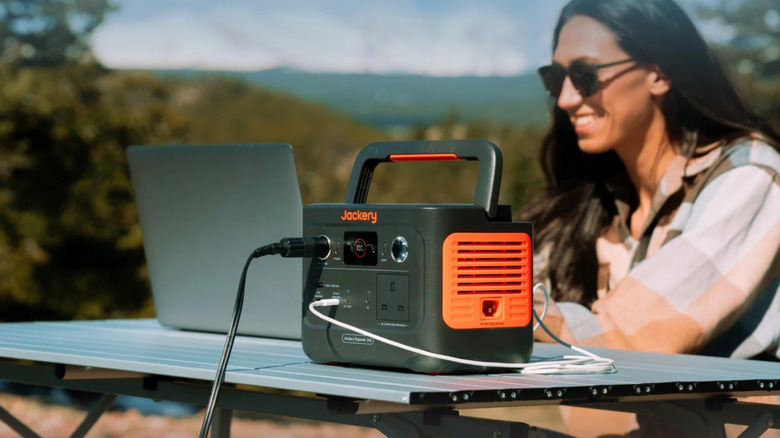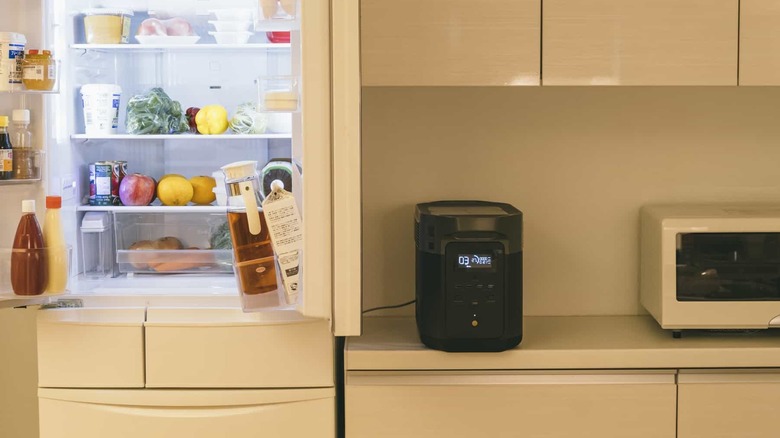Power Station Running Vs. Starting Watts: What's The Difference And Why It's Important
Unless you're living somewhere with extremely reliable grid power, you probably won't think about getting a portable power station. However, it's a completely different story when you experience outages more often than you'd like. In such cases, a power station becomes a need and not simply a nice-to-have. It can come in handy when you have to run your AC appliances during emergencies or charge your phones and laptops in a pinch. It's also one of the best ways to power your campsite or your RV whenever you're off the grid.
When checking out portable power stations, you'll often come across the terms starting and running watts. Sometimes, the starting watts is referred to as surge or peak wattage, while the running watts is the rated wattage. But what exactly do these terms mean, and how do they differ? Most importantly, why do they matter when selecting the right power station? Let's find out.
Difference between starting and running watts, explained
From its name, the starting watts is an appliance's temporary power consumption upon startup. When you switch on a fridge or an air conditioning unit, it needs a big amount of power for about two to three seconds to essentially kick start itself. This momentary spike is its starting watts.
Different appliances call for different starting watts. A window AC can consume up to 9,750 watts right when it starts, while a washing machine requires only 2,250 watts. Not every appliance demands a starting power, though. Light bulbs, space heaters, and irons all draw zero watts when they're turned on. Most of the time, you'll only see the starting watt requirement on appliances with a large electric motor since they need that extra kick to spin the built-in motor.
Running watts, on the other hand, refers to an appliance's actual power consumption. When it's up and ready, the appliance begins drawing less, typically two to three times lower than the starting watts. It then maintains this level throughout its operation until you turn it off.
Unlike starting watts, every appliance has running watts — they just differ from one machine to another. Modern TVs run at an average wattage of 70 to 400, while a clothes dryer needs about 1,800 to 5,000 watts to operate.
In terms of portable power stations, the starting watts is the amount of power the station can generate to start up the connected devices. It's considered the station's maximum wattage output. The running watts is the continuous generated power the station supplies to the machines to keep them running.
Why the starting and running watts even matter
One of the mistakes everyone makes with a generator or portable power station is using the wrong capacity. This could easily cause power fluctuations for your appliances and make the station itself overheat. So, before you pick the first power station you see in the store, you need to make sure that it can handle all the appliances you plan to connect to it, at the same time. But how exactly would you know if the wattage is the right size for your needs? That's where the starting and running watts of your appliances and power station come into play.
When load planning, list down all the rated wattages of the devices you'll simultaneously plug into the power station. You can find this either on the packaging, the rating label on the machine itself, the user manual, or the spec sheet on the manufacturer's website. If you see voltage and amperage values instead, just multiply the two to get the running watts. Then, add all these ratings up. The total should be within the rated output of the power station you'll pick.
But it isn't just the easily identifiable running watts you should consider. You also have to check if the station's starting watts is enough. A starting watts lower than what the appliances require won't start or power it on at all. To figure out the right peak wattage for the power station, refer to the Appliance Wattage Chart by EcoFlow. Look for your device that has the greatest starting watts. Then, take the sum of the running watts you computed earlier and include this specific starting watts. That's the surge peak your chosen power station should be rated at.


